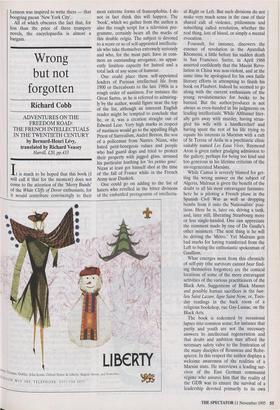Morning becomes electric
C. A. Hawtree
THE ENCYCLOPAEDIA OF NEW YORK CITY edited by Kenneth Jackson Yale, £40, pp. 13 50 6 of any city I have seen, I like New York best,' said that excellent poet and baseball enthusiast, Marianne Moore. `This electric town, which I adore,' wrote Wallace Stevens, when it was mostly powered by gas. Neither of these encomiums appears in the large, closely- printed, triple-columned pages of this well- bound encyclopaedia, but Stevens's metaphorical adjective sets one off on a free-associating trail (`electricity — see: light and power') interrupted only by the need to stand up and ease the thighs.
Naturally enough, this being the most beautiful city in the world, the book can prove fascinating and often causes one to halt a while. Here is an engrossing list of some 500 songs about the place — then, insistently, the curmudgeon ascends, to query the overlooking of 'What More Do I Need?' This Sondheim number, earlier than West Side Story and better than any- thing in that, has only lately come to wide attention, with the version by Dawn Upshaw last year on I Wish It So. The orchestration wittily matches this account of love in the Bronx transcending all: 'I hear a crane / making street repairs,/ a two- ton child / running wild upstairs. / Steam- pipes bang, / sirens clang, / and what more do I need? / The neighbours yell in the summer, / the landlord yells in the fall, / so loud I can't hear the plumber / pound the wall!'
It is this spirit that one soon, and often, comes to miss in turning these pages. If an encyclopaedia, duty bound to chisel the names of vanished mayors and to outline the history of commercial banking, cannot be as impressionistic and evocative as, say, E. B. White's essay 'Here is New York' or Joseph Mitchell's McSorley's Wonderful Saloon, that need not preclude the perti- nent wit which animates Carol von Pressentin Wright's Blue Guide or Paul Goldberger's architectural survey The City Observed (due tribute is paid to Jane Jacobs's The Life and Death of American Cities, without which Fifth Avenue would have ploughed through Washington Square Park and Grand Central Station been razed). The encyclopaedia's recitation of facts can have its own fascination, such as sewerage methods or Eighties subway graf- fiti (pioneered by somebody signing himself Taki 183), but word appears to have come down that no contributor should hang loose.
This might be welcome. The result, alas, is all too often dreary, a far cry from song- writer Alec Wilder's unpublished, much- rumoured, backstairs history of the Algonquin. The splendidly-named Brenda Wineapple — many contributors appear to have been created by Peter De Vries has but a few lines here to account for Dorothy Parker's fame, and she squanders these on such phrases as her 'wry, Swiftian clarity'; whether or not the great Dean was exactly wry, more effective would have been to supply an example or two of Miss Parker's wit and her Hellish circumstances (alas, Wineapple was also entrusted with Edna Ferber).
It was surely the booze and acerbity which made Tallulah Bankhead memorable rather than five years' touring in Private Lives. From a 700-word entry, written by three people, one learns of Miles Davis that 'after breaking both legs in an automobile accident in 1972 he retired in 1974 but resumed performing in 1981.' True, but those years saw him holed up at home, doing drugs and forever slamming the ham with tarts, which combination killed him (unlike Davis and Mapplethor- pe, Roy Cohn was a villain, and so presum- ably it was deemed all right to say that he died from AIDS).
Some entries, including one on Central Park, are written by experts. Others, one must infer, were farmed out on a random basis. The browser might go away with the impression that Louis Armstrong was 'the most important jazz singer' and that Can Can and Silk Stockings are among Cole Porter's three finest works (true, the latter contains 'All of You', but name another). An editor on a budget cannot hope for all- round brilliance but should keep an eye open, especially when James E. Mooney Ph. D is in the vicinity. He informs us, for example, that Wallace Stevens's work 'dis- played a refined poetic sense and a fond- ness for subtle imagery'.
One might hesitate to say that this unhelpful banality suggests a contributor who, busy with a history of Yale University Press, has not yet read Stevens, but then one chances upon his name below entries which aver that Auden wrote a novel and Yoko Ono 'Come Together' — indeed, all the John Lennon songs which Dr Mooney asserts were inspired by his move to New York City had been written and recorded in the seclusion of Ascot. With Wineapple's account of The New Yorker ringing in his ears (`scrupulous editing and fact checking'), Kenneth Jackson might have ventured to ask Dr Mooney why he did not replace these with a song that Lennon was inspired to write there — that boogying paean 'New York City'.
All of which obscures the fact that, for less than the price of three trumpery novels, the encyclopaedia is almost a bargain.



















































































 Previous page
Previous page